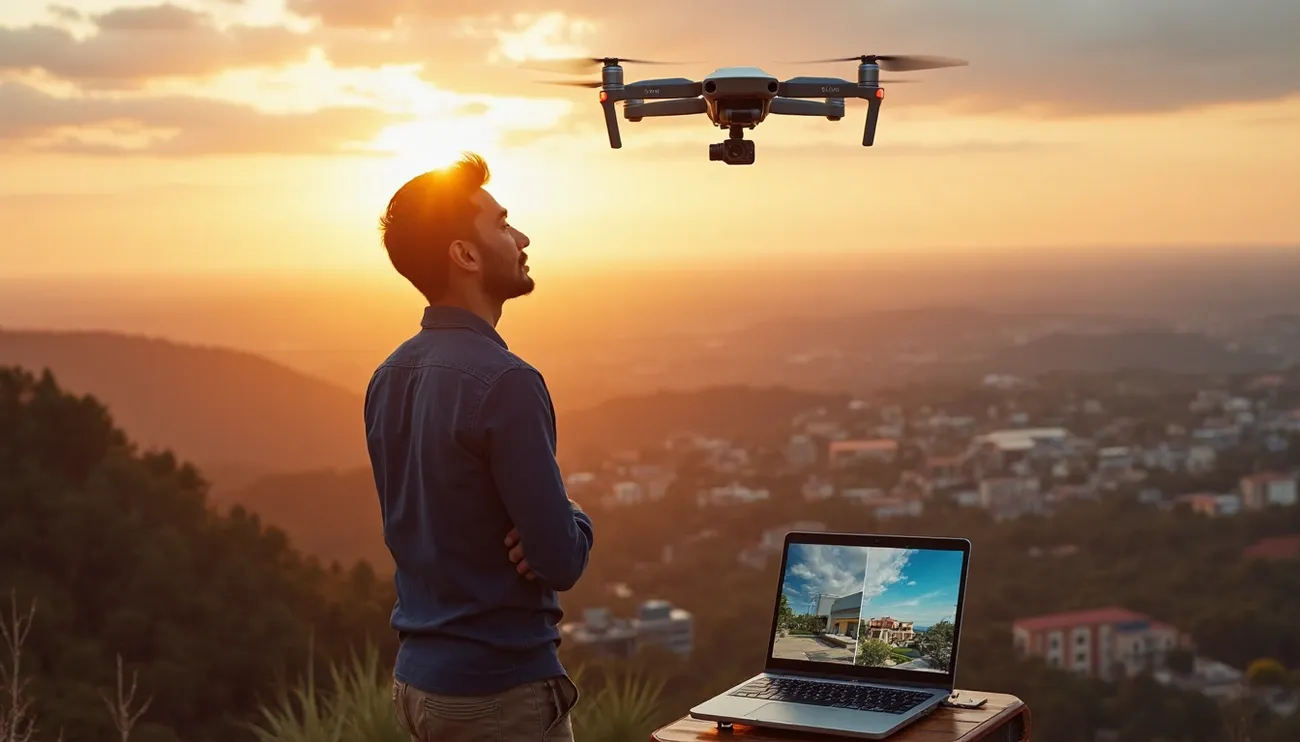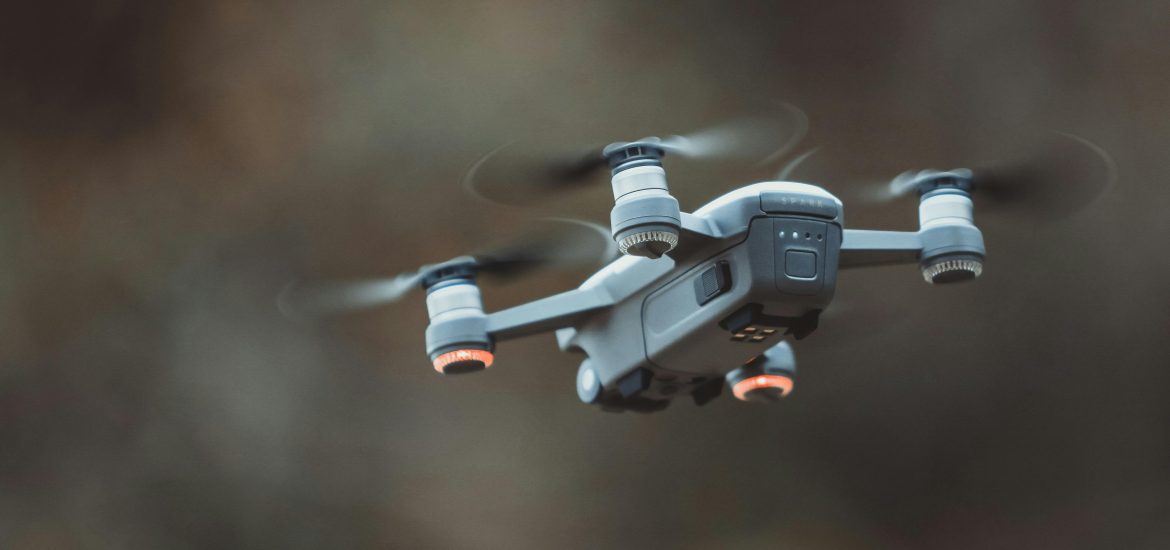
Did you know the global drone services market was valued at USD 13.9 billion in 2022 and is projected to skyrocket to USD 189.4 billion by 2030?
This explosive growth isn’t just impressive – it’s your opportunity. Experienced drone photographers are earning over $100,000 annually, turning their flying cameras into legitimate income streams. Instead of keeping your drone as a weekend hobby, you can transform it into a thriving business.
Starting a drone photography business might seem overwhelming at first. From obtaining your FAA Part 107 Remote Pilot Certificate to selecting the right equipment like the DJI Phantom 4 Pro, there’s certainly a learning curve. But with drones now offering stunning aerial perspectives once exclusive to professional pilots, the barriers to entry have never been lower.
Whether you’re a photography enthusiast looking to monetize your skills or an entrepreneur spotting an opportunity in this rapidly growing field, this guide will walk you through exactly how to start a drone business without the fluff or unnecessary complications. Let’s get your drone photography business off the ground!
Find Your Niche and Understand the Market
Success in drone photography starts with identifying your specialty. The commercial segment dominates the drone photography market with a massive 71% share, offering various profitable pathways for your business.
Popular drone photography niches
The drone photography services market is expanding across multiple industries, each with unique requirements:
Real Estate: Aerial property views have become essential for listings, making this niche consistently lucrative. Real estate aerial photography offers eye-catching perspectives that help properties stand out.
Mapping and Surveying: This technical niche accounts for over 32% of the market and is projected to exceed $2.9 billion by 2032. Modern sensor-equipped drones collect precise geographical data for detailed maps and 3D models.
Events and Weddings: Capture unique aerial perspectives of special occasions, providing clients with memorable cinematic footage that traditional photography cannot achieve.
Construction and Infrastructure: Document progress, perform inspections, and create site surveys—all increasingly vital for construction companies seeking comprehensive project documentation.
How to research local demand
Before launching your drone photography business, investigate where your services are needed:
First, examine which industries in your area actively use drone services. Real estate agents, event planners, construction companies, and marketing agencies form the primary target audience. Each sector has distinct needs—real estate requires property views while construction companies need progress documentation.
Additionally, track regulatory changes in your region. The easing of drone regulations in many areas has expanded accessible airspace, creating new business opportunities. North America leads with over 37% market share, largely due to its favorable regulatory environment.
Analyzing competitors in your area
Understanding your competition reveals opportunities for your drone photography business:
Start by identifying local drone operators offering similar services. Review their websites and social media to analyze their service offerings, pricing strategies, and client testimonials. Look for gaps you could fill—perhaps competitors don’t offer drone mapping or specialized industrial inspections.
Moreover, examine their visual style and quality. If most local competitors focus on basic real estate shots, you might differentiate by specializing in dynamic event coverage or precision agriculture monitoring.
The key to standing out is finding what excites you while meeting market demand. Your passion will fuel your persistence through the challenges of building your drone photography business.
Get Legal and Business Foundations in Place
Launching your drone photography business requires establishing proper legal and operational foundations. Failing to address these essentials could ground your business before it takes off.
FAA certification and local regulations
Operating a commercial drone in the U.S. requires obtaining an FAA Remote Pilot Certificate under Part 107 regulations. To qualify, you must be at least 16 years old, read and speak English, and be physically capable of safely operating a drone. The certification process includes:
- Obtain an FAA Tracking Number through the IACRA system
- Pass the Unmanned Aircraft General (UAG) knowledge test covering airspace classification, weather effects, and emergency procedures
- Complete FAA Form 8710-13 for your remote pilot certificate
- Receive your temporary certificate while awaiting your permanent one
Remember that your certificate requires renewal every 24 months through an online recurrent training course. Furthermore, you must register your drone with the FAA, which costs $6.97 for a three-year registration period.
Choosing a business structure (LLC, sole proprietorship)
An LLC structure offers significant advantages for drone photographers. Unlike a sole proprietorship, an LLC provides limited liability protection, shielding your personal assets from potential lawsuits arising from FAA violations or photographing private property without consent.
LLCs also offer tax flexibility and enhance your credibility with clients. To establish an LLC:
- Register with your state
- Obtain an Employer Identification Number (EIN)
- Open a business bank account
Why drone insurance matters
Though not legally mandated, drone insurance is practically essential. Most clients require at least $1 million in liability coverage. Comprehensive drone insurance typically includes:
- Liability insurance: Covers bodily injury or property damage caused by your drone to third parties
- Hull insurance: Protects your equipment from damage, loss, or theft
- Professional liability: Covers allegations of financial loss resulting from your services
Without proper coverage, a single accident could financially devastate your business. Even a gust of wind sending your drone into a building or a technical malfunction causing injury could result in substantial claims.
Build Your Toolkit and Skills
Choosing the right equipment forms the foundation of your drone photography business. Once you’ve handled the legal requirements, it’s time to focus on your toolkit and skills.
Top drones for beginners and pros
For beginners, the DJI Mini series offers an excellent entry point—particularly the Mini 4K at around CAD 418. Weighing under 250g, these drones require less regulatory oversight while delivering 4K video capabilities.
As your business grows, consider upgrading to the DJI Air 3S (approximately CAD 1,531) with its dual-camera system featuring both wide-angle and telephoto lenses. For professional-grade work, the DJI Mavic 3 Pro (starting at CAD 3,064) delivers a triple-camera system with Hasselblad color science.
Learning aerial photography techniques
Mastering composition significantly improves your drone photography. Focus on finding patterns, creating dividing lines between contrasting elements, and using symmetry in your shots. Subsequently, practice during golden hour when shadows add depth to your images.
Consider starting with a flight simulator to practice controls risk-free. Additionally, shoot in RAW format at base ISO (typically 100) for maximum post-processing flexibility.
Editing tools for photo and video
For drone footage editing, several options exist depending on your needs:
- LightCut: DJI’s recommended free app that connects directly to your drone
- DaVinci Resolve: Professional-grade free software with powerful color correction tools
- Adobe Premiere Pro: Industry standard for video editing
For photos, Adobe Lightroom excels at managing large batches of drone images, especially when adjusting exposure and enhancing colors.
Launch, Promote, and Grow Your Business
After mastering your skills and getting certified, marketing your drone services becomes your next mission. Building a thriving business requires strategic promotion and continuous expansion.
Creating a strong online presence
Your website serves as your digital portfolio and business card. Create a professional site showcasing your best aerial work, clearly outlining services and including client testimonials. For maximum impact, ensure your site is mobile-responsive with convenient service request forms. Similarly, leverage social media platforms strategically—Instagram and YouTube for visual content, Facebook for community building, and LinkedIn for connecting with commercial clients.
Networking with real estate agents and event planners
Forge partnerships with complementary businesses that don’t compete directly but serve similar clients. Real estate agents particularly value drone photography for showcasing properties with waterfront or large lots. Above all, attend industry events and join professional associations to establish valuable connections that lead to referrals.
Running ads and using SEO
Implement targeted Google Ads to reach people actively searching for drone services. Additionally, optimize your website for search engines by incorporating location-specific keywords like “drone photography in [city name]”. For local businesses, setting up a properly optimized Google Business Profile is essential.
Scaling with new services like mapping or video editing
Expand your offerings beyond basic photography to increase revenue streams. For instance, consider adding video production services for real estate agents and event planners seeking dynamic tours. Alternatively, provide specialized mapping and surveying using tools like DroneDeploy for construction companies and agriculture clients.
Conclusion
The drone photography industry presents a remarkable opportunity for those willing to take flight in this expanding market. Throughout this guide, you’ve learned how to transform your weekend hobby into a profitable business venture capable of generating six-figure income.
First and foremost, finding your niche remains critical to success. Whether you choose real estate, mapping, events, or construction, specializing allows you to develop expertise that clients will value and seek out. This specialization, coupled with proper research of local demand, positions your business for sustainable growth.
Legal compliance undoubtedly forms the backbone of your operation. Your FAA Remote Pilot Certificate, appropriate business structure, and comprehensive insurance coverage protect both your business and personal assets from potential liabilities. These foundations might seem tedious initially but will safeguard your business as it expands.
Equipment selection and skill development go hand-in-hand as you build your technical capabilities. From beginner-friendly DJI Mini drones to professional Mavic systems, your toolkit should evolve alongside your expertise and client demands.
Your marketing strategy ultimately determines how quickly your drone business takes off. A strong online presence, strategic networking with industry partners, targeted advertising, and search engine optimization all work together to attract your ideal clients.
The path from drone enthusiast to successful business owner requires dedication, continuous learning, and adaptability. Yet the rewards – both financial and creative – make this journey worthwhile. The drone services industry will continue expanding rapidly, therefore those who establish themselves now stand to benefit tremendously as market demand grows.
Start small, focus on quality, and gradually expand your services as you build confidence and clientele. Your drone isn’t just a flying camera – it’s your ticket to an exciting and profitable business venture. The sky truly is your only limit.
FAQs
Q1. How much can I earn with a drone photography business?
Experienced drone photographers can earn over $100,000 annually. The global drone services market is projected to reach $189.4 billion by 2030, offering significant income potential for those who establish themselves in this growing field.
Q2. What legal requirements do I need to meet to start a drone photography business?
You need to obtain an FAA Remote Pilot Certificate under Part 107 regulations, register your drone with the FAA, and consider forming an LLC for liability protection. While not legally mandated, most clients require at least $1 million in liability insurance coverage.
Q3. What are some popular niches in drone photography?
Popular niches include real estate photography, mapping and surveying, event and wedding coverage, and construction and infrastructure documentation. Each niche has unique requirements and potential for specialization.
Q4. What equipment do I need to start a drone photography business?
For beginners, the DJI Mini series offers a good starting point. As you grow, consider upgrading to more advanced models like the DJI Air 3S or DJI Mavic 3 Pro. You’ll also need editing software for photos and videos, such as Adobe Lightroom and Premiere Pro.
Q5. How can I market my drone photography business effectively?
Create a strong online presence with a professional website and active social media accounts. Network with real estate agents and event planners, use targeted Google Ads, optimize your website for local SEO, and consider expanding your services to include video production or specialized mapping to attract more clients.

